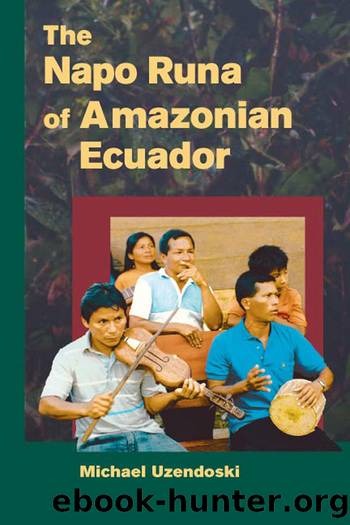The Napo Runa of Amazonian Ecuador by Michael Uzendoski

Author:Michael Uzendoski [Uzendoski, Michael]
Language: eng
Format: epub
Tags: Social Science, General, Anthropology, Cultural & Social
ISBN: 9780252092695
Google: xfekAGSQtqYC
Publisher: University of Illinois Press
Published: 2010-10-01T03:57:36+00:00
Figure 4. The In-Law in the Family Household
The literature on compadrazgo revisits some of the issues discussed earlier regarding the couvade. For example, Rivière (1974:432) ties the couvade ritual to compadrazgo as phenomena that concern spiritual links between physical and divine aspects of personhood and being.4 Similarly, compadrazgo is for the Runa an important part of the process of creating social persons and the relations that define them. Like other rites of passage, compadrazgo reflects both the exchange and the circulation of relationships. I agree with Pitt-Riverâs (1957, 1977) general point that compadrazgo must be studied in ethnographic context and in relation to the sociocultural systems of a particular peoples, without assuming it to be the same in all societies and cultures. Among the Runa, compadrazgo is defined by its relation to other relationsânamely, substance relations and affinal relations. I will now examine these relations in more detail.
Godparenthood carries with it a special terminology in Quichua. The Runa call the godfather âmarcayayaâ; the godmother, âmarcamamaâ; the godson, âmarcachuriâ; and the goddaughter, âmarcaushushi.â These categories are the normal parent-child kinship designations of yaya, mama, churi, and ushushi attached to the prefix marca-, a derivative of the Quichua term marcana (to hold or lift). When people ask someone to become a godparent to one of their children, they say, âCai wawara marcai,â which means âPlease hold my child.â The use of marcana is both a figurative and metonymic gloss. It is figurative because the context of becoming godparents is linked to the imagery of a parent cradling a child in his or her arms. It is metonymic because the relevant kinship designations (marcayaya, marcamama, marcachuri, and marcaushushi) are built on the previously discussed system of values related to substance categories between parents and children.
When one set of parents chooses another to become the godparents of their children, the childâs parents become compadres to the childâs godparents. Godfathers in general are sometimes referred to by the Quichua diminutive cumpa, which is short for compadre in the Napo vernacular. Whereas the kinship categories preceded by the prefix marca- connote a hierarchical parent- child relationship, compadre relations imply symmetry, mutual respect, and caring. The Runa say that compadres are permanent relations by which one must live llakisha, or âlovingly.â Because people collapse the notion of love with material and social exchanges, compadres are linked by reciprocal exchange relationships, in contrast to the exchange patterns of parental conviviality, which are necessarily giving and asymmetrical.
When a child reaches two to four years of age, the parents seek an appropriate couple to become the godparents of their child and act as compadres to them. When choosing compadres, people seek a relation of mature status that will be capable of fulfilling obligations to their child. As secondary parents, godparents are expected to foster the childâs development by, among other things, contributing to its material welfare. Godparents provide food, clothing, and other necessary items for their godchildren. Today schoolbooks and clothing are important. Godparents also give advice and take an
Download
This site does not store any files on its server. We only index and link to content provided by other sites. Please contact the content providers to delete copyright contents if any and email us, we'll remove relevant links or contents immediately.
| Argentina | Bolivia |
| Brazil | Chile |
| Colombia | Ecuador |
| Guyana | Paraguay |
| Peru | Suriname |
| Uruguay | Venezuela |
Cat's cradle by Kurt Vonnegut(15155)
Pimp by Iceberg Slim(14320)
4 3 2 1: A Novel by Paul Auster(12263)
Underground: A Human History of the Worlds Beneath Our Feet by Will Hunt(11997)
The Radium Girls by Kate Moore(11900)
Wiseguy by Nicholas Pileggi(5648)
Perfect Rhythm by Jae(5306)
American History Stories, Volume III (Yesterday's Classics) by Pratt Mara L(5239)
The Fire Next Time by James Baldwin(5224)
Paper Towns by Green John(5065)
Pale Blue Dot by Carl Sagan(4886)
A Higher Loyalty: Truth, Lies, and Leadership by James Comey(4822)
The Mayflower and the Pilgrims' New World by Nathaniel Philbrick(4403)
The Doomsday Machine by Daniel Ellsberg(4397)
Killers of the Flower Moon: The Osage Murders and the Birth of the FBI by David Grann(4368)
The Sympathizer by Viet Thanh Nguyen(4287)
Too Much and Not the Mood by Durga Chew-Bose(4256)
The Borden Murders by Sarah Miller(4216)
Sticky Fingers by Joe Hagan(4086)
